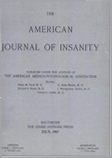CONCERNING THE CAUSE OF DEATH IN CERTAIN PSYCHOSES
Abstract
Clinical Features.—The majority of cases showed sudden onset of illness, there was a history of delusions and hallucinations, they showed extreme psychomotor excitement, restlessness and resistiveness to the point of negativism. They screamed and yelled as if in reaction to terrifying hallucinations. They showed an apprehensive affect changeable with blankness, stuporous rigidity, wetting and soiling, were mute and had to be tube fed in many instances. The manic-depressive cases who showed at onset a manic syndrome, were in the final stage undistinguishable from the others. Sensorium could not be evaluated.
Physically, the patients showed rapid bodily decline, severe metabolic disturbances, fluctuating temperature, leucocytosis. Blood pressure was falling. They showed toxic features such as loss of strength, loss of weight, digestive disturbance, increased pulse rate, dry tongue, and reflex symptoms such as flushing of the face, peristaltic unrest, circulatory disturbance, etc. Capillary skinreactions of the type of "flare" of Lewis were frequently observed. Occasionally stasis in the vena cava inferior was suggested by dilatation of superficial veins of the mammary region and that of pelvis and thighs. In the final stage, urine would show albumen, red cells, casts, increased specific gravity, etc., due apparently to intense congestion of the kidneys as will be shown later. The most interesting feature was the heart-action. The heart in such cases beats vigorously. The contraction is very weak, volume small, suggestive of emptiness, and of arterial oligæmia. Finally it comes to cessation of the heart-action. We believe however that paralysis of the heart can be excluded, and that what really happens is a collapse of the cardio-vascular system. All cases expired under the same circumstances.
Autopsy Findings.—Outstanding feature was that of practically uniform visceral congestion to the point of hemorrhagic states. The brain weighed from 1100-1434 gms., meninges often quite congested. Brain usually found to be large, boggy, congested, cedematous, at times suggesting acute swelling. Intracranial fluid usually increased, intracranial vessels in some cases proved to be rather thin, often appearing sclerotic. In some perivascular spaces were prominent. Smaller vessels undergo considerable change, showing some degeneration, being tortuous in their course. The capillaries in some places thickened, others obliterated, again some showing very thin walls and being rather narrow. Spleen was found almost universally hemorrhagic and broken down. Liver and kidneys extremely congested, at times showing swelling and in one case the liver showed small areas of necrosis. Adrenals were hemorrhagic in two cases. Pancreas showed intense congestion in two cases. Pituitary was quite engorged in several cases. The gastro-intestinal tract showed at times uniform congestion. In some cases the tract appeared diffusely red, and a network of venules stood out distinctly. Also, spots of bleaching were observed. Lungs showed intense hyperæmia, wide opening of capillaries, extravasation of blood and œdema in a number of cases. In one case there was evidence of capillary bronchitis. Pelvic organs showed the same picture of congestion. In the post-partum cases there was no evidence of infection in the genito urinary tract. No foci of infection were found in other cases. On the whole the picture was throughout suggestive for a toxic process.
Access content
To read the fulltext, please use one of the options below to sign in or purchase access.- Personal login
- Institutional Login
- Sign in via OpenAthens
- Register for access
-
Please login/register if you wish to pair your device and check access availability.
Not a subscriber?
PsychiatryOnline subscription options offer access to the DSM-5 library, books, journals, CME, and patient resources. This all-in-one virtual library provides psychiatrists and mental health professionals with key resources for diagnosis, treatment, research, and professional development.
Need more help? PsychiatryOnline Customer Service may be reached by emailing [email protected] or by calling 800-368-5777 (in the U.S.) or 703-907-7322 (outside the U.S.).



